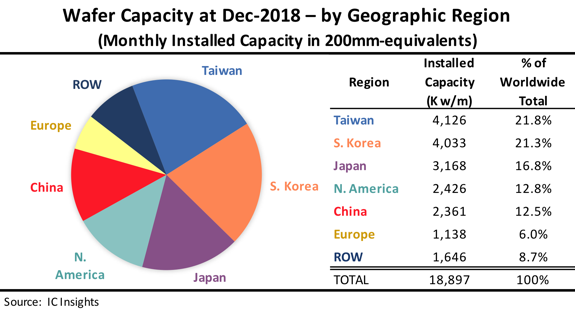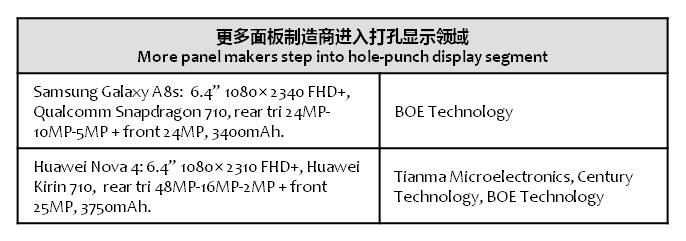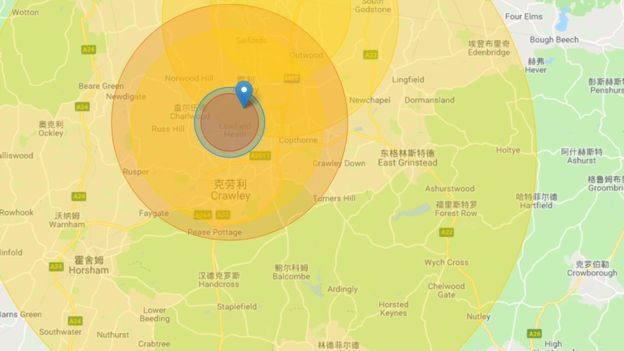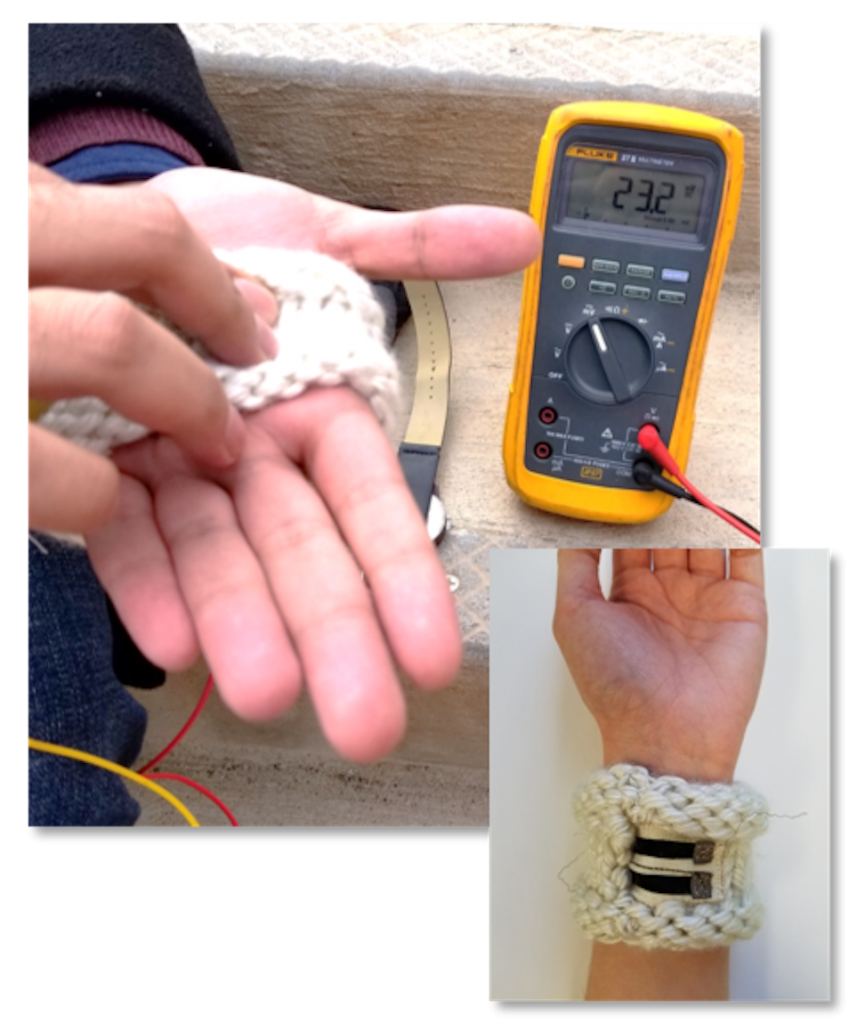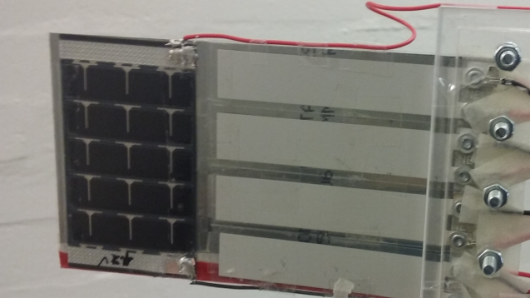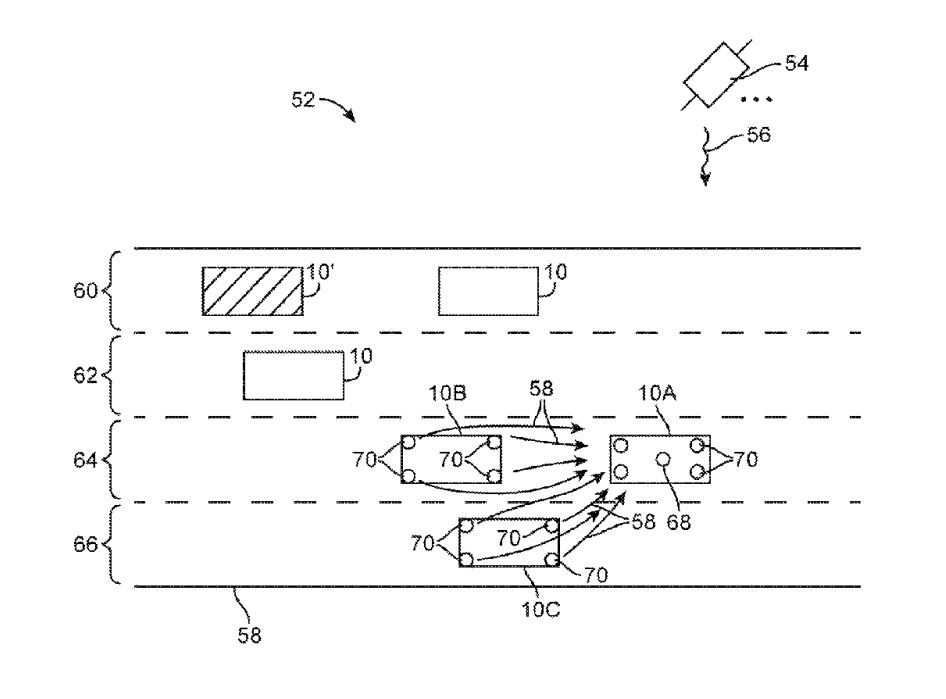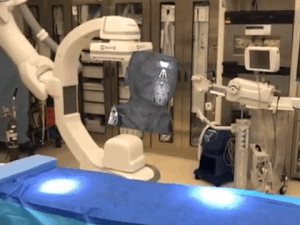
02-14 Happy Valentine’s Day: JDI will reportedly receive up to JPY80B in a bailout from a group of Chinese and Taiwanese investors; Google plans to unveil its first lower-priced smartphone in 2019 as part of an aggressive push into hardware; etc.
Chipsets
Taiwan foundry houses see poor order visibility for 2Q19, as domestic and international IC design houses need more time to digest their chip inventories, according to Digitimes. The order visibility for 12” wafer foundry services by TSMC and UMC has reportedly remained opaque for 2Q19, with sizes of orders received also shrinking slightly. And only their 8” wafer foundry fabs can maintain high capacity utilization rates in the short term. (Digitimes, press)
According to IC Insights, Taiwan led all regions/countries in wafer capacity with 21.8% share, a slight increase from 21.3% in 2017 (Taiwan first became the global wafer capacity leader in 2015). Taiwan’s capacity share was only slightly ahead of South Korea, which accounted for 21.3% of global wafer capacity in 2018. TSMC in Taiwan and Samsung and SK Hynix in South Korea accounted for the vast share of wafer fab capacity in each country and were the top three capacity leaders worldwide. (Digitimes, IC Insights, press, Inpai)
Touch Display
Ailing Apple supplier Japan Display Inc (JDI) will reportedly receive up to JPY80B (USD723M) in a bailout from a group of Chinese and Taiwanese investors. A group including China’s state-backed Silk Road Fund and Taiwanese panel maker TPK Holding will inject around JPY60B~80B, taking a stake of 30%-50% in JDI. (Apple Insider, Japan Times, Reuters, Sina, Sohu)
More flat panel makers are enhancing their deployments in the hole-punch handset panel sector as more handset brands will follow the steps of Samsung Electronics and Huawei to launch new models with hole-punch display design, according to Digitimes. Data compiled by Sigmaintell showed that the yield rate for the blind-hole displays had improved to 60-70% as of the end of January, which indicates that the supply of blind-hole displays will be stable in 2019. Global sales of hole-punch smartphones are estimated to reach 110M units in 2019 for a penetration rate of 8%, with the rate expected to rise sharply to 20% in 2020, Sigmaintell said. (Digitimes, press)
Camera
Largan Precision has begun shipping periscope lens modules and lens modules consisting of seven plastic lens pieces, and is poised to receive orders for in-panel optical fingerprint-recognition lens modules and 3D sensing lenses. Largan has also become a lens module supplier for China-based smartphone vendors including Huawei, OPPO and vivo, and Samsung. Among lens module makers, Largan stands a better chance of obtaining orders for 3-lens modules in 2019 due to competitiveness enabled by its economy of scale and technological capability. (Digitimes, press, China Times, UDN)
Memory
Advantech, a maker of server-grade memory, storage, and other components and solutions, is introducing a new lineup of 32 GB unbuffered DDR4 memory modules. Designed for high-performance computing (HPC) applications, the SQRAM-brand DIMMs use the latest DDR4 DRAM devices from Samsung, and feature additional reinforcements to make them suitable for industrial applications. Advantech’s SQRAM 32 GB DDR4 modules are based on Samsung’s 16 Gb DDR4-2666 memory chips. (CN Beta, AnandTech)
Sensory
While a number of China-based suppliers such as AAC Technologies, Jiangxi Liangchung Electronic and Crystal-Optech have entered the 3D sensor supply chain, China’s Android phone makers still rely on imports of some key components including vertical-cavity surface emitting laser (VCSEL) devices, diffractive optics element (DOE) products and infrared CMOS image sensors from international brands. Shipments of ToF-focused Android-based smartphones are likely to reach 20M units in 2019, Digitimes Research estimates. (Android Headlines, Digitimes, press)
DJI has announced an update to its European geofencing technology. The Geospatial Environment Online (GEO) 2.0 system is being rolled out across 32 European countries with new measures placed around airports with help from UK drone services platform Altitude Angel. (CN Beta, My Drivers, Altitude Angel, BBC)
Battery
University of Massachusetts Amherst has developed a fabric that can harvest body heat to power small wearable microelectronics such as activity trackers. In theory, body heat can produce power by taking advantage of the difference between body temperature and ambient cooler air, a “thermoelectric” effect. Materials with high electrical conductivity and low thermal conductivity can move electrical charge from a warm region toward a cooler one in this way. (CN Beta, My Drivers, Univ. of Massachusetts Amherst, Science Daily)
University of Manchester has designed flags that can produce energy via wind and solar power. The energy-harvesting device uses an inverted flag setup – where the leading edge is free to move but the trailing edge is secured. The body of the flags is made up of piezoelectric strips that harvest energy as the device flaps around in the wind and flexible photovoltaic cells which capture solar energy. (CN Beta, Power Technology, New Atlas, CNBC)
WiTricity, the industry pioneer in wireless power transfer, has announced the acquisition from Qualcomm Halo of certain technology platform and IP assets, which will bring to over 1,500 the number of patents and patent applications related to wireless charging that WiTricity will own or control. (Forbes, WiTricity, 36Kr)
Connectivity
Apple’s patent titled “Wireless vehicle system for enhancing situational awareness” describes a system for how a vehicle can interpret wireless messages from nearby electronic devices to determine their location relative to the car and their motion, and use the information to warn the driver or to take evasive action. (Apple Insider, USPTO)
Phone
Smartphone shipments in the China market is forecast to continue to fall over 10% on-year to below 80M in 1Q19 following an around 20% decline in 4Q18, according to Digitimes Research. (199IT, Digitimes, press)
Google plans to unveil its first lower-priced smartphone in 2019 as part of an aggressive push into hardware that it hopes will draw more users into its ecosystem. Pixel shipments in 2018 were around 4.68M units (around 0.33% of the total market), according to IDC. This compared with 3.45M units, or 0.2% of the market in 2017. (Digital Trends, Phone Arena, Asia Nikkei, Sina, IT Home)
Wistron and Foxconn plan to invest a combined INR7,500 crore over five years to expand their production facilities in India. Wistron has applied to the government to invest INR5,000 crore and Foxconn INR2,500 crore under an incentive package that will likely give these companies benefits of INR1,000 crore and INR500 crore, respectively. The government has so far approved as many as 193 of the 421 applications received under the modified incentive package scheme (M-SIPS), of which 144 have started incurring investments totaling INR9,252 crore. (My Drivers, Sina, Economic Times)
Wearables
The NDP report covers a 12-month period that ran through Nov 2018 and shows total unit sales of smartwatches up 61% year over year. Corresponding dollar sales were up as well, jumping 51% over the same period. That equates to nearly USD5B in sales, the firm said. (Apple Insider, NPD, Android Authority, 199IT)
Augmented / Virtual Reality
After 2 years of development, Medivis, a New York-based company developing augmented reality (AR) data integration and visualization tools for surgeons, is bringing its first product to market. With USD2.3M in financing led by Initialized Capital and partnerships with Dell and Microsoft to supply hardware, the company is launching its first product, called SurgicalAR. (TechCrunch, Bio Space)
Home
As Amazon.com and Google work to place their smart speakers at the center of the internet-connected home, both technology giants are expanding the amount of data they gather about customers who use their voice software to control other gadgets. For several years, Amazon and Google have collected data every time someone used a smart speaker to turn on a light or lock a door. Now they ask smart-home gadget makers such as Logitech and Hunter Fan to send a continuous stream of information. (CN Beta, Bloomberg, Bloomberg Quint)
Artificial Intelligence
Juniper Research has found that there will be 8B digital voice assistants in use by 2023, up from an estimated 2.5B at the end of 2018. While smartphone assistants will be the largest platform by volume thanks to Google Assistant and Apple Siri, Juniper found that the fastest growing voice assistant categories over the next 5 years will be: Smart TVs – 121.3% CAGR; Smart speakers – 41.3% CAGR; and Wearables – 40.2% CAGR. (Phone Arena, Business Wire, ZNDS)
Automotive
Volkswagen AG and Ford Motor allegedly have been unable to reach agreement on whether or how much the German automaker will invest in Ford’s self-driving vehicle unit. VW has resisted agreeing to invest in Ford’s autonomous vehicle unit, instead preferring to announce the companies will simply work together in that area. (CN Beta, Reuters, Channel News Asia, CNBC)
